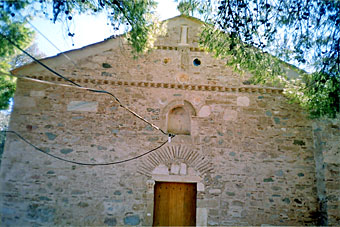Type: Timber - Roofed Basilica
Date: Phases
Description:
The church is situated in the south of the village. It is a timber-roofed, aisleless basilica. It was built on the foundations of an early Christian basilica of the 5th – 6th century, as it becomes evident by the arcades of the old basilica still visible in the external long sides of the church and the remnants of the big semi-circular apse around today’s conch. We can also conclude that it was built on an early Christian basilica by the masonry remnants in the southern and northern aisle of the basilica and the ample material (older than the Byzantine church) walled in the masonry of the church. The basilica was abandoned due to the destructions inflicted by the raids and pillages in the area during the first Christian years.
However, the veneration seems to revive during the Byzantine period. In this second phase the church is restricted in the middle aisle of the initial three-aisled basilica. This restriction moves the apse a little westward, while it enwalls the apses that become the long sides of the church. Orlandos revealed the first from the east unfluted column of the southern colonnade of the old basilica.
Thus, special traits of this church are its early Christian and Byzantine phases and the way they are integrated in the building reflecting the character and the history of the area at the time it was built. Characteristic is also the built screen with the incorporated early Christian sculptures as well as the twin shrine in front of the northern part, which consists of two monolithic, fluted columns with capitals decorated with acanthus and cane leaves. According to Orlandos, this screen dates to the Byzantine period.
Nowadays, the church, which used to be full of wall paintings, preserves in certain parts three layers of wall paintings. The last and visible layer dates to the late post-Byzantine period and includes representations of various figures and scenes (The Man of Sorrow, The Annunciation). Characteristic is the huge representation of Archangel Michael in the southern wall next to the screen. These wall paintings must refer to the work of the disciples of the 18th century painter Georgios Markos. Their work can be identified in a great number of churches in Mesogeia.











